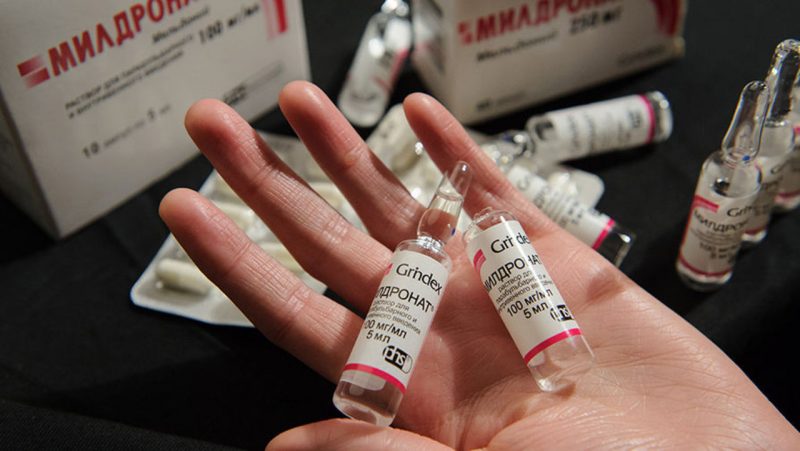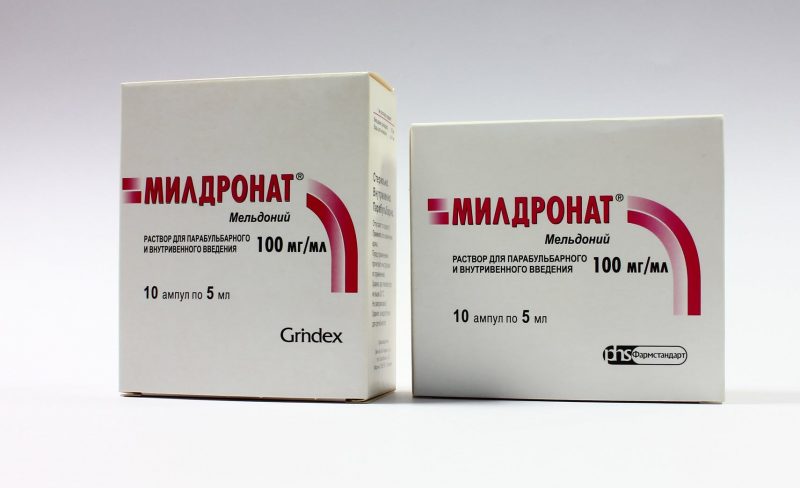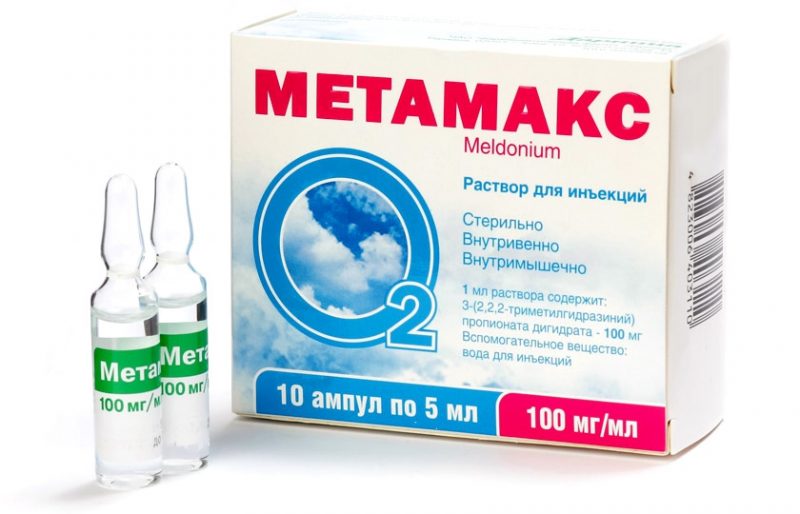Meldonium is a medication that regulates metabolic processes at the level of energy functions of cells. The key effect of meldonium on the body is to increase the survival of tissue cells in many disorders of the heart and brain against the background of ischemia (circulatory disorders) and hypoxia (oxygen starvation).
The substance was developed in 1975 by the Soviet professor Ivar Kalvinsh (currently the head of the department of medical chemistry at the Riga Institute of Latvia). Since 2012, in Russia, a pharmacological product has been included in the list of vital medicines.
Material Content:
What effect does meldonium have on the body?

In the process of therapy, a drug substance:
- supports cells of the heart and brain with poor blood supply and deficiency of incoming oxygen, preventing their death;
- prevents the development of ischemia (decreased blood supply) of the heart muscle and brain,
- in case of an existing blood supply disorder, it activates blood circulation in the area with affected cells;
- reduces the frequency of seizures in patients with angina pectoris;
- increases susceptibility to intense physical and intellectual activity during sports loads, preparation for exams;
- prevents exhaustion of the nervous system;
- increases immune resistance;
- activates blood circulation in the vessels of the retina of the visual organs.
Sports application
Meldonium is by no means a dope, and in sports activities it is used only as a means of protecting myocardial cells against the background of high-intensity work. With a rapid heartbeat during sports loads, oxygen starvation develops, which can lead to ischemia of the heart muscle. And the pharmaceutical product acts prophylactically, helping to restore strength between workouts, to increase the body's resistance to overloads.
In competitions, this pharmacological agent will not increase the speed, muscle strength and endurance of the athlete himself, but only reduce the risk of heart attack and stroke. That is, the therapeutic effect of the medication will be manifested in better tolerance of training and a more relaxed reaction of the heart and brain to an intense rhythm of activity.
With diabetes
Today, the effect of meldonium on the processes occurring in the body with diabetes is being actively studied. Medical tests have shown that the substance inhibits the growth of glucose levels, without increasing the level of insulin in the blood, the level of lactic acid, prevents loss of sensitivity.

The combination of meldonium and metformin, firstly, enhances the therapeutic effect of both drugs, secondly, removes the side effect of acidosis (increased acidity in the body) that occurs with long-term use of metformin, and thirdly, it contributes to a more pronounced effect of weight loss in patients prone to weight gain.
Indications for use
Under conditions of physical and emotional stress during cardiovascular and cerebral pathologies, intense physical exertion among athletes, Meldoniy is able to redistribute blood flow to areas experiencing the greatest oxygen deficiency, reduce the concentration of toxins during metabolic processes, protecting cell structure from damage that quickly compensate for energy losses . Evaluation of the pharmacological activity of the drug showed its beneficial effect in the treatment of cardiac ischemia, circulatory disorders of the cerebral tissues and their consequences. In people with these pathologies and myocardial insufficiency, the medicine is used to improve metabolic and energy processes in the cells of the heart muscle.

Due to its therapeutic property, Meldonium is widely used along with other medications in the treatment of many pathological conditions:
1. Angina pectoris, heart attack, pre-infarction and post-infarction state, dishormonal cardiomyopathy (cardiac muscle dysfunction due to hormonal deficiency), chronic myocardial ischemia, congestive heart failure.
The effect of the pharmaceutical product is the following effects:
- the heart muscle tolerates loads more easily due to an increase in the strength of myocardial contractions and the volume of cardiac output;
- increases the body's resistance to aggressive external factors;
- in acute heart attack, the drug inhibits the death of cells, reducing foci of necrosis (tissue necrosis) due to increased blood circulation in the affected area;
- the frequency of angina attacks decreases;
- the spread of pathological processes in the heart tissues slows down, the transition of the disease to a severe form is delayed;
- The recovery period after acute conditions is reduced.
2. Cerebrovascular (cerebrovascular) failure, ischemic stroke.
The drug reduces the severity of such vascular syndromes as:
- weakness, increased fatigue;
- headache attacks, fainting;
- decreased mental performance;
- neurological and emotional disorders, including panic attacks, depressive states;
- motor disorders (gait shakiness) and epileptic seizures;
- memory impairment, dizziness (often with nausea);
- hearing loss, tinnitus;
- "Blurring" of vision, the appearance of spots, threads and "flies" in front of the eyes;
- vascular dementia (intellectual disorders) against the background of vascular ischemia.
3.Dyscirculatory encephalopathy - damage to brain tissue as a result of slowly increasing circulatory disorders.
4. Myocardial dystrophy (myocardial dysfunction, not associated with inflammatory and degenerative processes), including the teenage form.
5. Diseases of peripheral vessels, thrombophlebitis, thrombosis.
6. Bronchial asthma.
7. High fatigue, physical, nervous and mental stress.
8. Neurological disorders amid depletion of the nervous system.
9. Reduced performance, general exhaustion of the body.
10. The period after serious illness and surgery to accelerate recovery.
11. Abstinence syndrome ("withdrawal syndrome") in alcoholism and drug "breaking". Meldonium helps relieve acute neurological disorders, improves intracellular metabolism, increases overall tone, and reduces the risks of pathological events such as heart attack and stroke.
12. Vascular disorders in the retina of the eye, including damage to diabetes, hypertension, dystrophic pathologies, hemophthalmus (blood entering the vitreous body during rupture of blood vessels), vein thrombosis, hemorrhage in the vitreous body, retina.
It should be clearly understood that the medication is most effective for preventing exacerbation of the above conditions, and in the treatment of diseases in the acute stage, it is used only as an adjuvant.
Release Forms
There are two therapeutic forms of Meldonium - capsules and injection solution for injection into a muscle, vein or steam - retrobulbar (into the fiber around the eye).

In 1 ml of the solution is 100 mg of meldonium, thus, in a 5 ml ampoule contains 500 mg of the therapeutic substance. In one package, 5 or 10 ampoules are placed.
One capsule may contain 250 or 500 mg of the active ingredient. Each blister contains 10 capsules. In one package, there are usually blisters with a total number of capsules of 30 or 60 pieces.
pharmachologic effect
Meldonium is a structural analogue of the enzyme gamma-butyrobetaine, which is present in cells.
Thanks to this enzyme, the concentration of carnitine in the body decreases, and the process of transporting fatty acids to myocardial cells slows down.
This delay is especially important in oxygen deficiency. With the usual intake of fats in the heart tissue and lack of oxygen, fatty acids are not completely oxidized. At the same time, toxic by-products of metabolism accumulate, poison the heart tissue and block the delivery of ATP acid molecules to the cells, the main energy supplier for all important processes.
By blocking the metabolism of fats, meldonium activates the metabolism of carbohydrates, in which there is a more intensive formation of ATP molecules and there is less oxygen demand, which allows cells to survive during oxygen starvation. At the same time, gamma-butyrobetaine has a relaxing and expanding effect on the vessels of the heart, brain and peripheral veins and arteries.
Meldonium: instructions for use

Application Features:
- The drug has a tonic effect on the nervous system, so because of the small stimulating effect, it is best to use the medicine for up to 15 hours. When appointing a three-time intake, it is optimal to take the last dose, if possible up to 17 hours, so as not to disturb the night's sleep.
- Capsules are swallowed whole before or after a meal, washed down with an average volume of water.
- Doses, multiplicity and duration of use is determined only by the doctor, taking into account the specific disease and in accordance with the instructions for use of the drug.
- The average dose most often prescribed for chronic processes: Meldonium in tablets is taken in 2 capsules of 250 mg 2 to 4 times a day, 500 mg 1 to 2 times. With the injection of a solution - 1 - 2 ampoules once (0.5 - 1 gram) or 1 ampoule - twice a day
- The standard duration of therapy is up to 14 - 20 days with the possibility of a second course at a similar interval.
Standard doses for certain types of pathologies
Angina pectoris in stable form, chronic myocardial dysfunction: in capsules - 250 mg three times a day (the first 4 days), then they drink the medicine in the same dose for 30-60 days, but only twice a week.
In case of a heart attack, unstable angina, the regimen is different in that in the first 3–4 days, 1–2 ampoules are injected once a day (intramuscularly or intravenously).
Acute cerebrovascular accident: for 10 days, 1 intravenous injection (1 ampoule) is given once a day, then capsules are taken for 20-30 days (500-1000 mg per day).

In the chronic process, an intramuscular injection (500 mg) is given once a day or 250 mg tablets are taken three times a day (3-4 weeks).
Withdrawal syndrome: in capsules - 4 times 500 mg, in severe cases, intravenous injections of 500 mg are required twice a day (up to 10 days). Particular attention requires the condition of the kidneys and liver.
Vascular and dystrophic pathologies of the eye: exclusively in injections of 0.5 ml of solution for 10 days.
Side effects and contraindications
Medication is prohibited:
- if the patient's age has not reached 16 years, if a woman is breast-feeding a baby or is expecting a baby (due to lack of research);
- with increased intracranial pressure;
- with violation of the outflow of blood through the veins;
- in the diagnosis of intracranial neoplasms;
- if the patient has an increased intolerance to meldonium.
In chronic renal and hepatic pathologies, the medication is prescribed with caution and with regular monitoring of urine and blood tests.
Adverse reactions while observing dosages do not appear often, among the main ones:
- overexcitation, drop or increase in blood pressure,
- heart palpitations;
- weakness, headache, dizziness;
- unpleasant sensations in the stomach, belching, diarrhea, gas formation.
Allergic reactions are very rare in the form of rashes, skin itching, bronchospasm or Quincke's edema. In the blood, against the background of an allergy, eosinophilia can be detected - an increase in eosinophils.
Analogs
The complete synonyms of Meldonium, that is, drugs with the same active substance and the same therapeutic effect: Mildronate, Angiocardil, Vasomag, Idrinol, Cardionate, Midolat, Mildrocard (in Belarus), Melfor, Medatern, Mildrakor (in Ukraine).

Analogs of Meldonium are medications with a similar or partial therapeutic effect, but with other active components: Metamax, Riboxin, Vasonate, Cefasel, Angiosil, Mexico.
Why Meldonium is banned - doping scandal
Meldonium was added to the WADA forbidden list class S4 as a hormone and metabolic modulator in January 2016. According to WADA, this medicine, similar to insulin, modulates metabolic processes and improves the results of athletes in competitions. Therefore, it was forbidden to accept before the competitions and during them.
The creator of the drug - biochemist Ivar Kalvins and other experts believe that in fact the studies did not prove that meldonium is able to increase the strength, speed or endurance of an athlete during a competition. It only protects the heart and the athlete’s brain during overload and accelerates the restoration of cellular structures.
This means that there is no real medical reason for including meldonium in the list of doping products, its prohibition is illegal and will only lead to increased mortality and disability among athletes.
Medicinal combinations
It can be used in parallel with medicines against arrhythmias and angina pectoris, blood thinners, antiplatelet agents, diuretics, bronchodilators. Caution when combined with drugs that lower blood pressure, cardiac glycosides, nitroglycerin, Nifedipine, alpha-blockers, agents that expand the vessels of the heart and brain.












